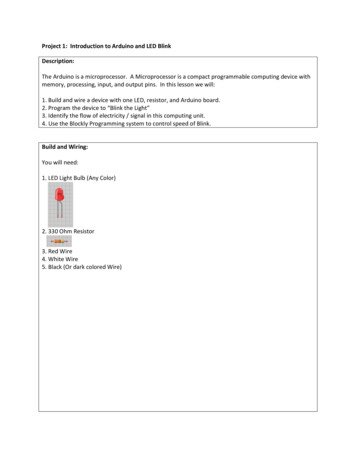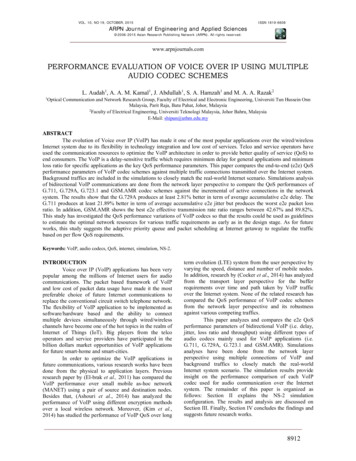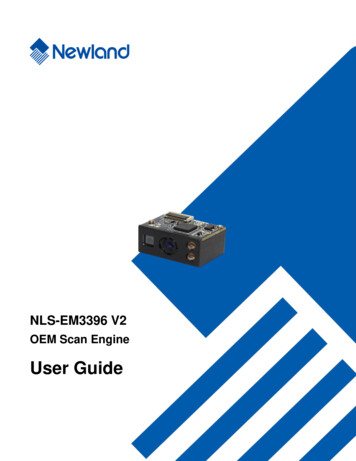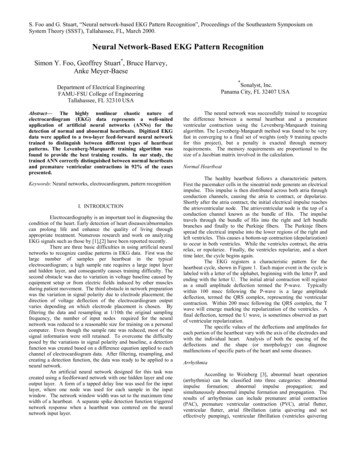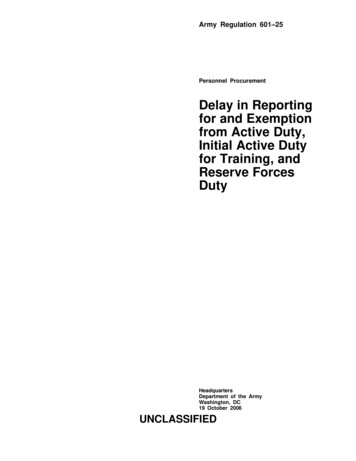
Transcription
Army Regulation 601–25Personnel ProcurementDelay in Reportingfor and Exemptionfrom Active Duty,Initial Active Dutyfor Training, andReserve ForcesDutyHeadquartersDepartment of the ArmyWashington, DC19 October 2006UNCLASSIFIED
SUMMARY of CHANGEAR 601–25Delay in Reporting for and Exemption from Active Duty, Initial Active Duty forTraining, and Reserve Forces DutyThis administrative revision, dated 19 October 2006-oCorrects organizational names and designations throughout.oChanges the address, 9700 Page Boulevard, St. Louis, MO 63132-5200 to 1Reserve Way, St. Louis, MO 63132-5200 throughout.This change-oAdds new supplemental service agreements (DA Forms 591e, 591g, 591h, and591f-R) for ROTC officers requesting educational delays who executed ROTCcontracts on and after 1 June 1984. This was the inception date of the 8-yearstatutory military service obligation (chap 2).oClarifies delay policy at time of mobilization (chap 4).oUpdates reference publications and makes administrative changes throughout.
*Army Regulation 601–25HeadquartersDepartment of the ArmyWashington, DC19 October 2006Effective 31 October 2006Personnel ProcurementDelay in Reporting for and Exemption from Active Duty, Initial Active Duty forTraining, and Reserve Forces DutyHistory. This publication is anadministrative revision. The portionsaffected by this administrative revision arelisted in the summary of change.Summary. This regulation covers policies and procedures for requesting andgranting delays and exemptions of certaincategories of officers and enlisted personnel. It covers policies and procedures forrequesting and granting delays and exemptions for reporting for active duty andReserve Forces Duty for officers. It alsocovers delays and exemptions for enlistedpersonnel who are ordered to initial activeduty for training.Applicability. This regulation applies tothe Active Army, the Army NationalGuard/Army National Guard of the UnitedStates, and the U.S. Army Reserve, unlessotherwise stated. During mobilization,procedures in this publication can bemodified to support policy changes asnecessary. This regulation applies to unitmembers of the Army National Guardunder the Early Commissioning Programand during mobilization. More specifically it applies to—a. Participants in the Reserve Officers’Training Corps program.b. Participants in Army Medical Department officer procurement programsmonitored by the Surgeon General.c. Army National Guard and U.S.Army Reserve unit members appointedunder the Early Commissioning Programand current participants in the Early Commissioning Program.d. Certain Army Medical Departmentofficers ordered to involuntary activeduty.e. Army National Guard or U.S. ArmyReserve members and individual U.S.Army Reserve control group members ordered to active duty during a mobilization.f. Enlisted personnel ordered to activeduty for training.g. Officer personnel ordered to activeduty or Reserve Forces Duty.h. Participants in the Army NationalGuard Medical and Dental Student Commissioning Program and Reserve of theArmy Medical, Osteopathic, Dental, andVeterinary Student Commissioning Program (Army Reserve).Proponent and exception authority.The proponent of this regulation is theDeputy Chief of Staff, G–1. The DeputyChief of Staff, G–1 has the authority toapprove exceptions to this regulation thatare consistent with controlling law andregulation. The Deputy Chief of Staff,G–1 may delegate this authority in writingto a division chief within the proponentagency in the grade of colonel or the civilian equivalent. Activities may request awaiver to this regulation by providing justification that includes a full analysis ofthe expected benefits and must includeformal review by the activity’s seniorlegal officer. All waiver requests will beendorsed by the commander or seniorleader of the requesting activity and forwarded through their higher headquartersto the policy proponent. Refer to AR25–30 for specific guidance.Army management control process.This regulation does not contain management control provisions.Supplementation. Supplementation ofthis regulation and establishment of command and local forms are prohibited without prior approval from HQDA, DeputyChief of Staff, G–1. Send requests toHQDA, Deputy Chief of Staff, G–1,DAPE–MPE–IP, 300 Army Pentagon,Washington, D.C. 20310–0300.Suggested improvements. Users areinvited to send comments and suggestedimprovements on DA Form 2028 (Recommended Changes to Publications andBlank Forms) directly to HQDA, DeputyChief of Staff, G–1, DAPE–MPE–IP, 300Army Pentagon, Washington, D.C.20310–0300.Distribution. This publication is available in electronic media only and is intended for command levels C for theActive Army, A for the Army NationalGuard/Army National Guard of the UnitedStates, and A for the U.S. Army Reserve.*This regulation supersedes AR 601–25, 7 March 1986.AR 601–25 19 October 2006UNCLASSIFIEDi
Contents(Listed by paragraph and page number)Chapter 1Introduction, page 1Purpose 1–1, page 1References 1–2, page 1Explanation of abbreviations and terms 1–3, page 1Responsibilities 1–4, page 1Suspension of delay 1–5, page 1Right to appeal 1–6, page 1Chapter 2Delay and Exemption of Officer Procurement Program Members, page 1Section IGeneral, page 1Officer procurement programs 2–1, page 1Assignment 2–2, page 2Training program 2–3, page 2Delay categories 2–4, page 2Section IIParticipants in ROTC Programs, page 3Request for delay or exemption 2–5, page 3Renewal of delay 2–6, page 6Exception to maximum delay 2–7, page 6Reserve assignment 2–8, page 6Responsibilities 2–9, page 9Failure to graduate 2–10, page 10ROTC Officer Accession Program booklet 2–11, page 10Section IIIParticipants in Health Professional Programs, page 11General 2–12, page 11Periods of delay 2–13, page 11Renewal of delay 2–14, page 12Exception to maximum delay 2–15, page 12Responsibilities 2–16, page 12Failure to graduate 2–17, page 13Section IVParticipants in Early Commissioning Programs, page 13Initial delay 2–18, page 13Postgraduate delay and miscellaneous delays 2–19, page 13Delay control 2–20, page 14Section VEssentiality or Community Hardship of Medical and Dental Program Participants, page 14Request for delay or exemption 2–21, page 14Initial applications for delay or exemption 2–22, page 14Request for renewal of delay 2–23, page 15Board of officers 2–24, page 15Board decisions 2–25, page 15Appeal procedures 2–26, page 15iiAR 601–25 19 October 2006
Contents—ContinuedSection VIExtreme Personal Hardship of Medical and Dental Program Participants, page 15Request for delay or exemption 2–27, page 15Initial applications for delay or exemption 2–28, page 15Request for renewal of delay 2–29, page 16Chapter 3Enlisted Members Ordered to Initial Active Duty for Training, page 16Initial active duty for training for enlisted personnel 3–1, page 16Medical disqualification of alternate training program members 3–2, page 16Delay and exemption 3–3, page 17Exception to delay periods 3–4, page 18Chapter 4Delay and Exemption During Mobilization, page 18Section IPartial and Full Mobilization, page 18General 4–1, page 18Availability 4–2, page 18Section IIFull Mobilization, page 19Availability 4–3, page 19Responsibilities 4–4, page 20Section IIIPartial Mobilization, page 20Delay or exemption 4–5, page 20Period of delay 4–6, page 21Application for delay or exemption 4–7, page 21Approving authority 4–8, page 22Responsibilities 4–9, page 22Board of officers 4–10, page 23Approved exemptions 4–11, page 23Medical fitness procedures during partial mobilization 4–12, page 23Chapter 5Peacetime Medical Fitness Procedures, page 26Temporary medical disqualification 5–1, page 26Applications and documentary evidence 5–2, page 26Chapter 6Appeals, page 27Eligibility 6–1, page 27Appeal procedures 6–2, page 27Appeal board 6–3, page 27Appeal authority 6–4, page 27Appendix A.References, page 28Table ListTable 2–1: Reasons for Delay in Entry on AD/IADT/RFD, page 7Table 2–2: Educational Subject Codes for Branch Detail, page 10AR 601–25 19 October 2006iii
Contents—ContinuedFigure FormatFormatforforforforforforrequest for delayed entry on initial active duty or Reserve Forces Duty, page 5unit delay authorization, page 20request for exemption from involuntary active duty and request for discharge, page 22request for additional delay for sick or injured personnel, page 24delay authorization letter, page 25report on return of sick or injured personnel letter, page 26GlossaryReproducible FormsivAR 601–25 19 October 2006
Chapter 1Introduction1–1. PurposeThis regulation prescribes policy and procedures for delay in and exemption from entry on active duty (AD), initialactive duty for training (IADT), and Reserve Forces Duty (RFD) for members of the Army National Guard of theUnited States (ARNGUS) and the U.S. Army Reserve (USAR). Exceptions will be made on an individual basis only byHeadquarters, Department of the Army (HQDA).1–2. ReferencesRequired and related publications and prescribed and referenced forms are listed in appendix A.1–3. Explanation of abbreviations and termsAbbreviations and special terms used are explained in the glossary.1–4. ResponsibilitiesOverall responsibilities are listed below. Specific responsibilities are given in the chapters.a. The Surgeon General (TSG) monitors all of the programs for Army Medical Department (AMEDD) participants.b. The Chief, National Guard Bureau (CNGB) monitors Army National Guard (ARNG) unit members until individual is mobilized during a mobilization.c. The Commanding General, Human Resources Center, St. Louis (CG, HRC–STL) has administrative control overall individuals delayed from entry on AD, IADT, or RFD during peacetime. Also, HRC–STL has control over membersof the Individual Ready Reserve (IRR) and Standby Reserve until mobilized during a mobilization.d. Reserve Officers’ Training Corps (ROTC) region commanders monitor ROTC program participants. Also, theyshare some administrative responsibility with HRC–STL for members commissioned under the Early CommissioningProgram (ECP).1–5. Suspension of delayWhen there are overriding military requirements, the Department of the Army (DA) may suspend the authority to grantdelays or may terminate previously granted delays.1–6. Right to appealAn individual whose request for delay or exemption from entry on AD, IADT, or RFD is denied is entitled to appeal tohigher authority as specified in this regulation.Chapter 2Delay and Exemption of Officer Procurement Program MembersSection IGeneral2–1. Officer procurement programsa. These programs procure commissioned officers to meet the needs of both the active Army and the ReserveComponent and to meet mobilization requirements. The following personnel are members of officer procurementprograms:(1) ROTC Cadets.(2) Officers appointed from the ROTC program who have not completed a tour of AD or RFD.(3) Officers approved for participation in AMEDD officer procurement programs listed in paragraph 2–13b.(4) ROTC officers appointed under the ECP.(5) Officers commissioned in the USAR from a military junior college (MJC).(6) Officers commissioned in the USAR to prepare for the Army Chaplaincy.b. Participants in officer procurement programs may be delayed from entry on AD or RFD for the reasons andperiods discussed in this chapter and shown in table 2–1.c. Exemption will be granted when information or documentary evidence reveals that total relief from the requirement to report for AD or RFD is justified. Processing will be under AR 135–133 and AR 135–175.d. Officers delayed from entry on AD or RFD are authorized to participate in reserve activities as described inparagraph 2–3.e. ROTC officers granted an educational delay remain liable for AD or RFD in accordance with the needs of theAR 601–25 19 October 20061
service. This liability is assumed when accepted for educational delay and may extend beyond the agreement executedwhen enrolled in the ROTC advanced course. Resignations will not be accepted from officers who have not completedAD or RFD unless very exceptional circumstances exist. Examples are national health, safety or interest, or extremecompassionate circumstances.2–2. AssignmentDelayed members of officer procurement programs will be assigned to USAR Control Group (Officer Active DutyObligor) (OADO), HRC–STL. Officers granted a category X delay will remain in their initial assignment. Whenassignment to an ARNGUS or USAR unit is authorized, the CG, HRC–STL retains administrative control during thedelay. If the unit is mobilized, the officer will report to active duty with the unit.2–3. Training programa. Officers detailed to Staff Specialist Branch, specialty skill identifier (SSI) OOA5 may apply under AR 165–1 forparticipation in the educational and training programs for Staff Specialists (chaplain candidate). Send applications toHRC–STL, ATTN: AHRC–RDD–O, 1 Reserve Way, St. Louis, MO 63132–5200, at least 60 days before the trainingdate requested.b. Participants in the AMEDD ECP (AR 601–130, chap 4) and officers delayed to study medicine, osteopathy, ordentistry may apply for participation in the Clinical Clerkship Training Program. Send applications through the deansof the medical or dental schools to HRC–STL early enough to reach TSG by 1 January.c. ROTC officers delayed under this regulation may apply for participation in Reserve activities as a member of aspecific troop program unit of the ARNGUS or USAR. Send applications to HRC–STL, ATTN: AHRC–RDD, 1Reserve Way, St. Louis, MO 63132–5200, for approval. This paragraph does not apply to delayed officers who are inthe Health Professions Scholarship Program (HPSP) or the ROTC Advanced Scholarship Program. Include thestatements listed below.(1) A statement from the ARNG or USAR unit commander that—(a) There is a unit vacancy in a specified branch and SSI.(b) The applicant is acceptable for assignment to the unit.(c) The commander understands that the applicant will not be a deployable unit asset until he or she completes aresident officer basic course.(d) The commander agrees to release the member for assignment to AD if selected by the Human ResourcesCommand, Alexandria,VA (HRC–A).(2) A statement (signed by applicant) of understanding that—(a) Service will not be credited toward fulfillment of the obligation to perform AD or RFD, if assigned to an ARNGor USAR unit.(b) Delay will automatically be terminated; the member will be ordered to AD with the unit, if the unit to which amember is assigned is mobilized or otherwise ordered to AD,.(c) Delay must be renewed annually in accordance with instructions furnished by HRC–STL, ATTN: AHRC–RDD,1 Reserve Way, St. Louis, MO 63132–5200.(3) Approved applicants will be—(a) Placed by HRC–STL in the branch and specialty called for by the unit vacancy. Only officers meeting therequirements in DA Pamphlet 611–21 may be assigned to an AMEDD branch. Applicants who are later selected forAD may be considered for branch transfer by HRC–A based on the needs of the Army.(b) Required to renew their delay annually in accordance with instructions furnished by CG, HRC–STL.d. ROTC officers appointed under the ECP are assigned to an ARNGUS or USAR unit and remain under theadministrative control of the CG, HRC–STL. ECP officers will mobilize with their unit of assignment.2–4. Delay categoriesDelay categories authorized officer procurement program participants are as follows:a. Category A.(1) ROTC participants completing postgraduate studies.(2) Participants in the AMEDD ECP (AR 601–130, chap 4).b. Category B.(1) ROTC officers awaiting professional licensing in a specialty allied to health or health related fields.(2) A participant in an AMEDD officer procurement program other than participants in the AMEDD ECP.c. Category C. Extreme personal or community hardship.d. Category D. For other cogent reasons.e. Category E. ROTC officers appointed under the ECP, assigned to an ARNG or USAR unit, and pursuing abachelor’s degree.f. Category X. For administrative reasons when entry on AD or RFD is delayed because of processing. Applies2AR 601–25 19 October 2006
when officers do not enter AD or RFD during the same month in which their category A, B, C, D, or, E delayterminates. This administrative delay is to be used solely for accounting purposes. (See table 2–1, rules 16 and 24.)Section IIParticipants in ROTC Programs2–5. Request for delay or exemptiona. Postgraduate delay.(1) Eligibility. An ROTC graduate or potential graduate may request a postgraduate delay for one of the reasons andperiods shown in table 2–1. The guidelines below also apply. (For personnel under the ECP, see para 2–19.)(a) ROTC applicants must be enrolled for full-time graduate or professional study in an approved and recognizedinstitution of higher education. Any law school attended must be approved by the American Bar Association. Classesmust begin the first regular semester or quarter following appointment. Delay to attend an accredited or approvedmedical, dental, or veterinary school located in other than the 50 States, District of Columbia, Puerto Rico, or a U.S.territory is not authorized.(b) Priority for approval of educational delay for scholarship cadets will be given to cadets requesting study in adiscipline for which the Army has valid requirements.(c) Delay to pursue a combined degree program (for example, juris doctorate/master of business administration) thatwould require a longer period than authorized to obtain a postgraduate degree is not authorized. (See table 2–1, rules 1,2, 3, 4, and 6.)(d) Delay to pursue graduate study in nursing requires approval of TSG.(2) Period of delay. An initial educational delay (category A) may be granted in 1-year increments. (See para 2–6for renewal of delay.)(3) Applications. Applicants who are going beyond initial postgraduate delay will submit requests by formal letter(fig 2–1), in triplicate. Send applications to HRC–STL, ATTN: AHRC–RD, 1 Reserve Way, St. Louis, MO63132–5200. Initial postgraduate delay applicants will use DA Form 591 (Application for Initial (Educational) Delayfrom Entry on Active Duty and Supplemental Agreement). Complete in triplicate. Follow the instructions on the form.Obtain verification of enrollment or acceptance for enrollment from the appropriate school official (part II, DA Form591). One of the supplemental forms listed below must accompany DA Form 591. Send DA Forms 591 to the ROTCregion commander. (Applicant is advised to retain a copy of all documents submitted.)(a) DA Form 591a (ROTC Supplemental Service Agreement (Initial Educational Delay)) to ROTC contractsexecuted before 1 June 1984 or DA Form 591e (ROTC Supplemental Service Agreement (Initial Educational Delay))to ROTC contracts executed on and after 1 June 1984.(b) DA Form 591b (ROTC Supplemental Service Agreement for Special Medical Program Participants) to ROTCcontracts executed before 1 June 1984 or DA Form 591g (ROTC Supplemental Service Agreement for Special MedicalProgram Participants) to ROTC contracts executed on and after 1 June 1984.(c) DA Form 591c (ROTC Supplemental Service Agreement (Army Chaplaincy)) to ROTC contracts executedbefore 1 June 1984 or DA Form 591h (ROTC Supplemental Service Agreement (Army Chaplaincy)) to ROTCcontracts executed on and after 1 June 1984. This form will be completed only by students of religion theology whoare preparing for the military chaplaincy. Include documentation requested for assignment to the staff specialist branch(chaplain candidate) special skill identifier (SSI) OOA56 (AR 135–100). All other students of theology will completeDA Form 591a or DA Form 591e, as appropriate.(d) DA Form 591d–R (ECP Student Supplemental Service Agreement (Postgraduate Delay)) to ROTC contractsexecuted before 1 June 1984 or DA Form 591f–R (ECP Student Supplemental Service Agreement (PostgraduateDelay)) to ROTC contracts executed on and after 1 June 1984. DA Forms 591d–R and 591f–R will be locallyreproduced on 81 2 11 inch paper. Copies for local reproduction purposes are located at the back of this regulation.(See the section covering ECP participants, para 2–19a.)(4) Approval authority for initial postgraduate delay. Approval of initial delay to obtain a postgraduate degree isbased on the Army’s need for officers with advanced degrees in an academic discipline. The CG, HRC–A is theapproval authority for these requests except requests for delay to pursue graduate studies in law or in medical relatedfields. In these areas, the approval of the Judge Advocate General (TJAG) or TSG, as appropriate, will be obtained bythe CG, HRC–A.(5) Processing initial postgraduate delay and requests. The ROTC Region commander will send DA Form 591 andappropriate supplemental form as described in (3) above to HRC–A, AHRC–OPP–P, Alexandria, VA 22332–0400. CG,HRC–A will approve or disapprove the requests for delay to pursue graduate studies in law or in medical related fields.(a) The CG, HRC–A will obtain the approval of TJAG or TSG for initial postgraduate delay requests in the medicalrelated fields or law. Approval to attend law school does not entitle one to be commissioned in the Judge AdvocateGeneral’s Corps (JAGC) upon graduation from law school. An officer must still apply during his or her third year oflaw school and be competitively selected for JAGC. Law school performance will be a significant factor in the JAGCcommissioning decision.AR 601–25 19 October 20063
(b) The CG, HRC–A will notify the ROTC region commander of approval or disapproval on all requests.(c) The ROTC region commander will notify the requester of the decision. If request is approved, the ROTC regioncommander will issue orders transferring the individual to USAR Control Group (OADO).b. Further delay. An individual who has attained the degree objective for which granted a delay may be consideredfor further delay. Other types of further delay are listed below. Submit applications in triplicate to HRC–STL, ATTN:AHRC–RD, 1 Reserve Way, St. Louis, MO 63132 –5200. Use the letter format in figure 2–1 and include the followingdocumentary evidence.(1) Personal hardship. (See para 2–13d(2)(a).)(2) Essentiality or community hardship. (See para 2–13d(2)(b).)(3) Employment.(a) Seasonal. The employment must be the individual’s normal occupation and primary source of income. Supporting documents must show that seasonal employment will not be available if the applicant is required to enter AD orRFD on the regularly scheduled date. (See explanation of seasonal employment in the glossary.)(b) Initial. A statement from the employer certifying that initial employment will not be available if the applicant isrequired to enter AD or RFD on the regularly scheduled date. The statement must include training courses dates andcertification that the member must accept the position. Also, include certification that the member must take training toinsure reemployment upon completion of AD or RFD.(4) Participation in a general election. A statement from an authorized representative of a recognized political party.It must say that the applicant is an official party candidate in a primary or general election for Congress or State publicoffice (table 2–1, rule 13). Delay is not authorized to take part in preliminary political activities for nomination as anofficial party candidate.(5) Federal or State appointment. Evidence of appointment to a Federal or State public office or to a Federal Court.(See table 2–1, rule 14.)(6) Professional license or certification. A copy of the Federal or State examination schedule and evidence showingacceptance to take the examination on a specific date. Delay for this reason does not apply to medical or dentalofficers. (See table 2–1, rules 8 and 12.)(7) Legal clerkship. Documentary evidence of acceptance to serve a legal clerkship (table 2–1, rule 5). HRC–STLwill coordinate with TJAG and the appropriate career branch if the applicant is not selected for a commission in theJAGC.(8) Pursuit of a doctoral degree when initial delay was for a master’s degree. Approval will depend on the overallneeds of the service for junior officers with a doctoral degree in the subject discipline. (See table 2–1, rule 7.)(9) Medical fitness delay. (See chap 5 for peacetime medical fitness procedures.) (For full mobilization, see chap 4,sec II; for partial mobilization, see chap 4, sec III.)c. Exemption. When information or documentary evidence reveals that total relief from the requirement to report forAD or RFD is justified, the member will be granted an exemption; processing will be under AR 135–133 and AR135–175.4AR 601–25 19 October 2006
Figure 2–1. Format for request for delayed entry on initial active duty or Reserve Forces DutyAR 601–25 19 October 20065
2–6. Renewal of delaySubmit application for renewal of delay in accordance with HRC–STL instructions. An individual’s delay may beterminated if the completed renewal form is not returned within 30 days.2–7. Exception to maximum delayDelay beyond the maximum period shown in rules 1, 2, 3, 4, 6, 7, and 11 of table 2–1 is not authorized unless anexception is granted by HQDA. Send application by letter (fig 2–1) in triplicate to HRC–STL, ATTN: AHRC–RD, 1Reserve Way, St. Louis, MO 63132–5200. A request for exception to the maximum period in table 2–1 must give thereason and full justification for further delay. Justification may include (but is not limited to) the following documentary evidence:a. Statements from a graduate school official or from the applicant if substantiated by the school official. Thesestatements concern an individual’s—(1) Degree program and progress.(2) Estimated date of completion of work, research, or presentation of thesis or dissertation.b. Substantiating documents from an institution official. These are required if abnormal difficulty in completingclassroom work, experiments, or research was caused by experiment failure or similar reasons.c. Substantiating documents from a doctor or minister. These are required if abnormal difficulty in completing thedegree program, classroom work, experiments, or research was caused by personal hardship or illness.d. List of school requirements for completing the degree program. This is required for request for exceptionexceeding a total of 12 months. If the estimated date for completing the studies differs from the one given in thepreviously submitted request for delay, furnish justification for the change.2–8. Reserve assignment(See para 2–4 for description of delay categories.)a. Officers granted a category A or B delay will be assigned to USAR Control Group (OADO), HRC–STL. ROTCregion commanders will issue orders.b. Officers granted a category E delay will be assigned to an ARNG or USAR unit. The CG, HRC–STL will retainadministrative control. ROTC region commanders will issue orders.c. Officers granted a category C or D delay will remain under the jurisdictional control of the ROTC regioncommander approving the delay, except as outlined in d below.d. Officers elected or appointed to Congress, appointed to a Federal Court or to a Federal or State public office, andthose elected to a public office of a State will be immediately transferred to USAR Control Group (Standby–Inactive).e. Officers granted a category X delay will remain in their initial assignment.6AR 601–25 19 October 2006
Table 2–1Reasons for Delay in Entry on AD/IADT/RFDRULE If thememberisand the reason for delay is—1to pursue a degree in medi- 2–5acine, dentistry, veterinarymedicine, osteopathy, optometry, sanitary engineering, social work, psychology, or podiatryDA Form 591and DA Form591b/DA Form591g or DA Form591d–R/ DAForm 591f–RA12annuallymonthsStudent is automatically considered as a participant in theAMEDD Early CommissioningProgram (AR 601–130). Maximum delay will not exceed 48months from date appointed.TSG may authorize furtherdelay. (See note 1.)2to study one of the Medical 2–5aAllied Sciences listed in AR680–29 and AR 601–25,paragraph 2–9b(5)(a)DA Form 591and DA Form591a/DA Form591e or DA Form591d–R/DAForm 591f–RA12monthsannuallyMaximum delay will not exceed 36 months. (See note1.)3to pursue religious studiesin preparation for the Armychaplaincy2–5aDA Form 591and DA Form591c/DA Form591hA12annuallymonthsPeriod required to completestudies.Scholarship Cadetswill not be delayed to studyReligion Theology. SS application in accordance with AR135–100. (See note 1.)4to pursue a first degree inlaw (Bachelor of Laws orDoctor of Law)2–5aDA Form 591and DA Form591a/ DA Form591e or DA Form591d–R/DAForm 591f–RA12annuallymonthsMaximum delay will not exceed 36 months. (See note1.)5to accept a legal clerkship2–5b(7) letter (fig 2–1)D12not aumonths thorizedAuthorized for JAGC officersonly, unless approved byHRC–STL.6to pursue a master’s degree 2–5ain any other subject discipline (includes religion otherthan 3 above)A12annuallymonthsmaximum delay will not exceed 24 months. (See note1.)7to pursue a doctoral degree 2–5b(8) letter (fig 2–1)when initial delay was for amaster’s degreeA36not aumonths thorized(Seenote 2.)An individual may apply whenwithin 3 to 6 months of completing original degree objective.8to obtain a professional li2–5b(6) letter (fig 2–1)cense in a specialty allied toa health or health relatedfieldB12not aumonths thorized9extreme personal hardship2–5b(1) letter (fig 2–1)C6seemonths remarksmay be renewed once withHQDA approval10extreme community hardship2–5b(2) letter (fig 2–1)C6seemonths remarksmay be renewed once withHQDA approval11seasonal or initial employment2–5b(3) letter (fig 2–1)Dseenot authe latest date–6 months fromremarks thorizedappointment or end of currentunless ap- delayproved byHQDAanROTCofficerand doc- then he or she may and beumented
Army National Guard or U.S. Army R e s e r v e m e m b e r s a n d i n d i v i d u a l U . S . Army Reserve control group members or-dered to active duty during a mobilization. f. Enlisted personnel ordered to active duty for training. g. Officer personnel ordered to active duty or Reserve Forces Duty. h. Participants in the Army National







